The drainage of rain runoff from the streets is one of the sore points for residents of many cities. A light rain has passed, and you can't reach the entrance - a huge puddle has formed on the way. The situation is familiar to you, isn't it? But how can you get rid of it?
The solution to the problem lies in the correct arrangement surface drainage on city streets. And what it is and what other problems this system solves - we will discuss all the questions in our article. We will tell you about the device of linear and point drainage, we will give recommendations for the selection of suitable materials. We will also touch on the issue of design, legislative regulation and installation of the system.
The content of the article:
-
What problems does the drainage system solve?
- Benefits of surface drainage
- Drainage of waste water from various objects
-
Types and device of surface drainage
- Features of the linear drainage system
- What is a point drainage made of?
- Recommendations for the selection of materials
-
Subtleties of design and installation of the system
- How is a drainage project drawn up?
- Key rules for installing the system
- Drainage Regulatory Requirements
- Conclusions and useful video on the topic
What problems does the drainage system solve?
The problem of removing rain and melt water, as well as runoff from watering and washing streets, is quite relevant in a modern city. To solve it, they equip a surface drainage system - a set of trays, sand traps, drainage wells and other elements of engineering equipment, assembled into a single system drainage system.
Benefits of surface drainage
The drainage system effectively removes excess moisture and water from precipitation, sending it away from residential buildings, roads, parks, squares. That allows you to remove the hydraulic load on roads and foundations of apartment buildings and cottages. And, as a result, to extend their service life by 2-3 times.
Visually about the problems arising due to improperly equipped drainage or its complete absence in the next photo collection.
Image gallery
Photo from
The lack of a drainage system on the streets of the city or its improper functioning leads to unpleasant consequences, which, unfortunately, are witnessed by residents of many cities
Flooding of the basement of an apartment building is also quite common. From which the inhabitants of many cities suffer. Therefore, if the surface drainage system was not equipped at the construction stage, then you should think about its arrangement.
Insufficient drainage of groundwater or regular flooding of the basement of a residential building leads to an increase in the level of humidity, the appearance of mold and, as a result, the formation of an unhealthy microclimate in the basement and in apartments on the ground floor building
The ingress of melt water and a high level of groundwater - all this negatively affects the foundation of both an apartment building and a private house. As a result, this structural element fails too quickly - cracks appear, which can soon lead to complete destruction if measures are not taken in time
Comfortable recreation areas of the townspeople can suffer greatly as a result of regular flooding. Excess moisture has a detrimental effect on the root system of shrubs, trees and flowers
Untimely drainage of wastewater from a flower bed is an excess of moisture, which has an extremely negative effect on ornamental varieties of plants and flowers. Instead of an exquisite flower bed, a dirty swamp forms
The lack of a drainage system in the park, in the square and in other favorite recreation places of the townspeople leads to the impossibility of improving the territory. After rain, excess water is not removed in a timely manner - as a result, the soil subsides and falls through
Without surface drainage, even the road surface breaks down too quickly - there is a lot of water, it is removed extremely slowly, actively washes away the soil and sections of the road simply fail
The street is flooded
The basement is flooded
Mold in the basement
Cracks in the foundation
Plantations flooded
The flower bed is destroyed
The tile is crumpled
Dips on the road
As you can see, a properly designed and well-assembled drainage system has a number of advantages:
- You can improve the territory by planting flowers, shrubs, equipping recreation areas.
- The system allows you to protect the foundation of buildings from destruction, to increase the overhaul interval.
- In basements and basements, water will not accumulate and stagnate, which will extend their service life.
- The absence of an increase in the level of humidity will prevent the formation and spread of mold, fungi and other harmful microorganisms.
- Timely drainage will avoid soil leaching and extend the life of the road surface and paving slabs.
In other words, the presence of surface drainage makes it possible to create comfortable conditions for the operation of streets, adjacent territories, recreation and entertainment areas for the townspeople.
Drainage of waste water from various objects
Due to frequent and sometimes intense precipitation, the issue of drainage is especially relevant - within the city limits, even 2 mm of precipitation produces a runoff. The reason for this is waterproof coatings, which are present in large quantities - this is asphalt on roads and yards, roofs of houses, etc.
Therefore, it is so important to timely collect surface water from the local area, parking lots, stations, parks, squares, roads, bridges and other objects. What the drainage system successfully copes with, collecting wastewater and directing it to treatment facilities.
Image gallery
Photo from
The airport also needs a reliable drainage system. Moreover, due to the enormous load, the construction material must be of high strength. Runway load class - F900
Surface drainage systems on bridges are also a must during the design and construction phase. They are also subject to increased strength requirements. Depending on the purpose of the bridge, the load class corresponds to E600, F900
When building roads, a prerequisite is the arrangement of a surface drainage system. However, these requirements are not always met in practice. Therefore, lack of drainage is one of the reasons why most roads are in poor condition. Highway load class - E600
Sports complexes must be equipped with a drainage system. Moreover, they use not one type, but combine several drainage systems at once in order to achieve ideal conditions and ensure complete safety for spectators and athletes.
In parks, squares and squares, linear drainage must be used. This measure allows you to quickly remove runoff from precipitation, melt water, preventing the formation of puddles, water stagnation and deformation of the coating. When paving paving stones, the load class for the drainage system is A15
Underground car parks should be user-friendly. Therefore, when arranging them, it is important to have an effective drainage system, which will allow you to remove drains in a timely manner. Load class for such objects - B125
When improving the local area, it is imperative that a drainage scheme is included in the project. That will keep the flower beds and road surface in perfect condition. Load class - A15
So that water does not stagnate and dirt does not form on the territory of industrial facilities, such zones also need effective drainage. When assembling systems, especially durable materials are used that can withstand a significant load when moving heavy waste equipment. Load class - E600
Airport drainage system
Drainage from bridges
Highway drainage
Linear drainage of the stadium
Drainage system on the square
Underground parking with linear drainage
Linear and point drainage
Drainage of industrial facilities
The importance of drainage from various territories in a city can hardly be overestimated. Thanks to a well-equipped system for collecting melt and surface runoff, the hydraulic load is reduced, which has a positive effect on the external state of structures and objects, on the intervals between repairs and the duration of the overall service life.
Types and device of surface drainage
The surface drainage system can be point and linear. Most often, these two types of drainage are combined to ensure effective drainage functions. Next, we will consider what elements such systems consist of. We will also talk about the materials from which individual elements are made for assembling the system, and the rules for choosing the right one.
Features of the linear drainage system
The linear type of drainage arrangement allows you to quickly remove wastewater from a large area, for example, along the perimeter of an apartment building, a stadium or from a roadbed.
The linear drainage system consists of rain gutters, protective grids, reservoirs for retaining sand (sand traps) and other structural elements. The mounted system is connected to the sewer.
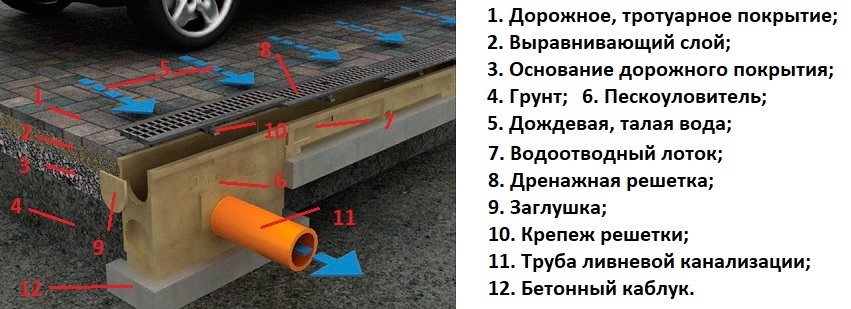
Lattices covering the top of the drainage tray protect it from the penetration of large debris and guarantee the safety of the movement of pedestrians and vehicles
All components for assembling the drainage system are made of fiber-reinforced concrete, concrete, polymer concrete, plastic, stainless steel. Depending on the place of installation and the expected loads, products of a standard or reinforced series are selected.
Consider their features on example of Standartpark productsconsisting of a basic and reinforced series.
Series products Basic (standard) assumes use in conditions of light traffic - park areas, transitional sidewalks, sports facilities, cottages and landscaping of the local area. Load class A15-C250, which corresponds to a weight of up to 25 tons.
The hydraulic section of the trays is 100-300 mm. Manufacturing material of elements: polymer concrete, fiber-reinforced concrete, plastic (trays), stainless steel, galvanized steel, copper, cast iron (protective grilles).
Series Drive (reinforced) - the products are designed for operation under conditions of increased load from 25 to 60 tons, strength class from C250 to E600. Designed for use in areas with heavy traffic, including heavy goods vehicles. Made from plastic, polymer concrete and durable concrete. The hydraulic section (width of the product structure) is 100, 150 and 200 mm.
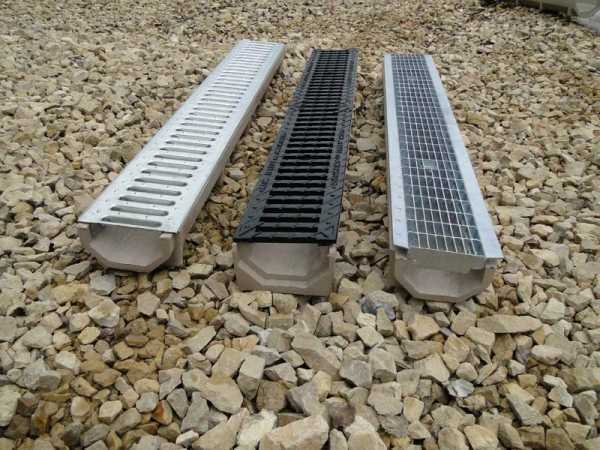
Trays and protective grilles of various colors and dimensions. They are installed along roads, along the perimeter of houses and cottages, to collect wastewater from the local area.
Reinforced series Max differs from the previous ones in the increased level of load - the products have a high strength class D400, E600 or F900, which allows them to withstand loads up to 90 tons.
For manufacturing, reinforced concrete, polymer concrete and plastic are used, reinforcing the trays with galvanized nozzles. The grilles are made of high-impact cast iron.

A feature of the Max series is the ability to fasten bolts and nuts. This design provides high maintainability of linear drainage.
What is a point drainage made of?
Another type of surface drainage is local storm water inlets (point, local). They, like the linear system, collect wastewater in order to further direct them into the storm drain. But the collection takes place at one point - under the drainpipe, under the watering tap, at the entrance to the house, at the entrance and other places where puddles are most likely to form.
The device and the main structural elements of the point system can be found in the following image.
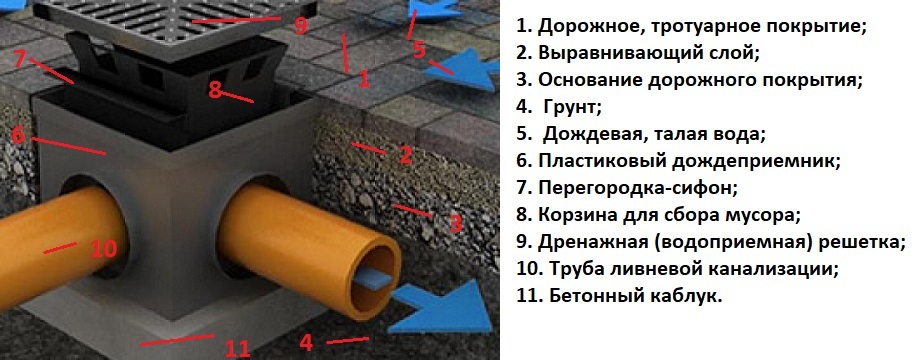
The point type of drainage allows you to effectively collect wastewater into the storm water inlet. Which is closed from above with a protective grill made of durable material
Let's consider the characteristics of products for assembling a point system using the example of Standartpark products:
- Standard series Basic - point drainage system, including a plastic rain collector and a water intake grate. It can be completed additionally with a waste collection basket and a siphon partition. The structures are intended for installation in places with a low load - light traffic of cars and pedestrians.
- Reinforced series Max designed for high and extra-high loads. Storm tanks (wells) are made of polymer concrete and fiber-reinforced concrete, reinforced with galvanized steel nozzles. The grids for protecting the storm water inlet are made of heavy-duty cast iron, which corresponds to the load of the D400 E600 and F900 classes.
Stormwater inlets can be used as sand traps or drainage wells. To build a well, you need to install several containers on top of each other, thus increasing the required length. Multi-section storm water inlets are also used as inspection chambers.
Spot elements can be mounted in conjunction with a linear system - the reinforced series is suitable for as sand traps for reinforced chutes, the hydraulic section of which is 300, 400, 500 mm.
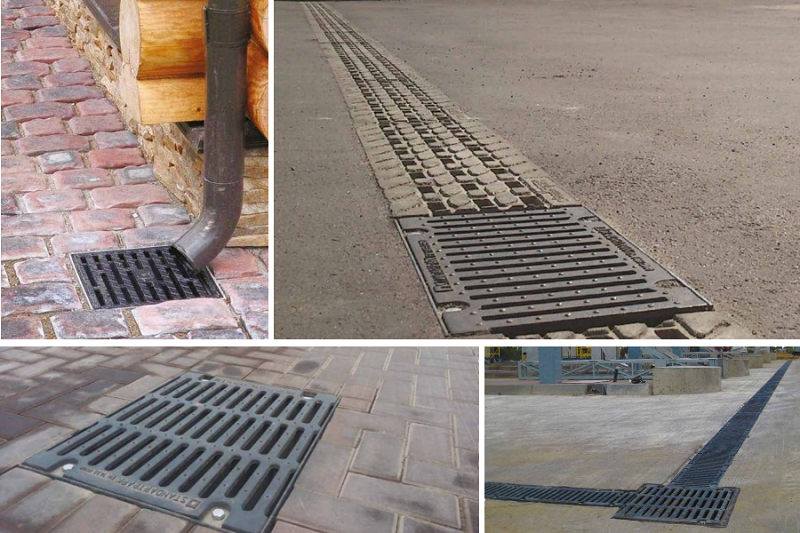
The construction of reinforced storm water inlets allows connection to sewer pipes. In addition, the stormwater tank can be equipped with a removable waste basket. Which is easy to get out and clean as it fills
If you are interested in arranging drainage for domestic use, we recommend that you look at the information on the manufacture and connection homemade drainage well.
Recommendations for the selection of materials
Operating conditions - the fundamental criterion on which to rely when selecting the elements of the system. Therefore, it is so important to take into account exactly where the system will be installed, what loads are expected, and the climatic features of the region.
Let's talk in more detail about the nuances that should be considered when choosing equipment for installing a surface drainage system, especially trays and protective gratings:
- load class;
- hydraulic calculation;
- bandwidth;
- distance to the collector.
Strength class (load) is the maximum allowable weight, under the influence of which the product will not lose its performance. In the production of trays, they are guided by the EN 1433 standard.
Water consumption or hydraulic calculation calculated in l / s, when calculating which take into account:
- precipitation intensity according to SNiP 2.04.03-85;
- runoff surface coefficient;
- drainage area;
- the standard rainfall in the region.
Also no less important is the parameter bandwidth tray - that is, its ability to drain a certain amount of waste per second. This is especially important in case of heavy rainfall or intense snow melting. For example, with a hydraulic diameter of 200 mm, the drainage capacity of a plastic tray is about 18 l / s, for a concrete and polymer concrete product, this figure is up to 11 l / s.
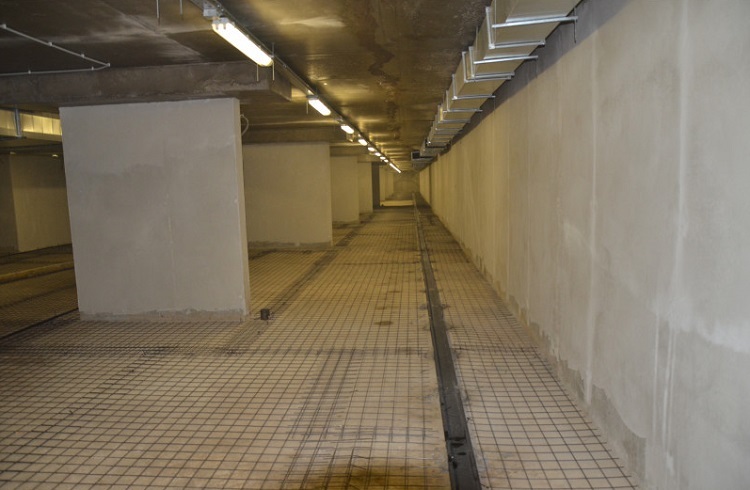
When measuring the distance of the drainage from the place where the drain is received before it is sent to the collector, the slope angle must be calculated, which directly affects the water flow rate
It is important that the high drainage capacity corresponds to the safety factor of the individual elements from which the drainage system is assembled.
Subtleties of design and installation of the system
Drafting and installing a drainage system is an initial task that must be performed at the beginning of construction. At the same time, it is important to approach the issue of wastewater drainage, both in the city and in a country estate, in a comprehensive manner, taking care of immediately surface drainage, the arrangement of storm sewers, household waste disposal, and improvement territory.
How is a drainage project drawn up?
When designing a surface drainage system, it will be necessary to take into account a number of factors, including the relief, amount of precipitation, type of soil, depth of groundwater placement, type of object, purpose and operating conditions object.
To draw up a project, you should contact the design service, whose specialists will draw up a project in accordance with the norms and requirements of SNiP.
Why do you have to provide such documents:
- The master plan of the site, where the dimensions and location of all buildings and structures are marked.
- Site plan with topographic survey of the area, indicating the location of the waste storage tank / drainage well.
- Technical report on the geotechnical conditions of the territory.
When drawing up a project, specialists will definitely select the appropriate equipment for arranging the system, indicating the strength class and the required number of structural elements.
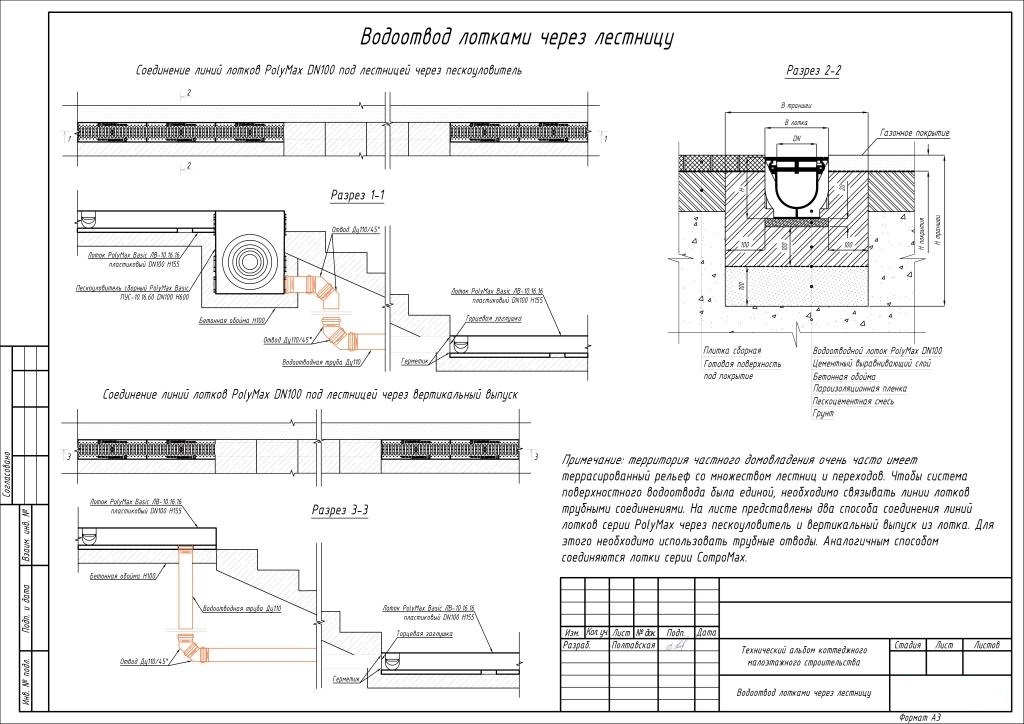
The diagram shows an example of a technical solution for drainage by trays through a staircase using a reinforced series for arranging linear drainage
Design consists in calculating and choosing the optimal place for laying linear drainage.
The project includes the following calculations and schemes:
- Placement of linear drainage trays.
- Calculation of the hydraulic section of the trays, selection of their optimal location.
- Locations of sectional storm water inlets, taking into account the expected points of maximum discharge of effluents.
- Connection points of drainage pipes (their slope angle) and inspection wells with an indication of their location on the plan.
- Installation diagrams of all elements of the drainage system - trays, storm inlets, inspection wells.
- A comprehensive list of all elements necessary for arranging the system - trays, storm water inlets, pipes, wells, hatches and all accessories.
Such a project will make it possible to implement an effective surface drainage system for a specific area. For example, you can go to the following link and see an example point drainage.
We have other articles on the design of drainage systems on our website:
- Site drainage project: selection of location, slope, depth, drainage system elements
- Calculation of storm sewers: analysis of important design features
Key rules for installing the system
The installation of the system is carried out in accordance with the approved project and taking into account the recommendations of a particular manufacturer, from which elements of the surface-type drainage system are purchased. By the way, all the components are best purchased from one manufacturer, whose products suit you in terms of their characteristics and price category.
Next, we will briefly consider the basic rules and stages of installation of a surface drainage system.
First, with special grippers, workers manually fill and seal the water pipelines. Then a concrete "pillow" is poured into the trench, the thickness of which is indicated in the recommendations of the manufacturer of the trays. A line is marked with a cord for laying the trays for collecting the drain.
The first step is to install sand traps, and then proceed to the installation of trays, installing them end-to-end. All connection points are sealed.
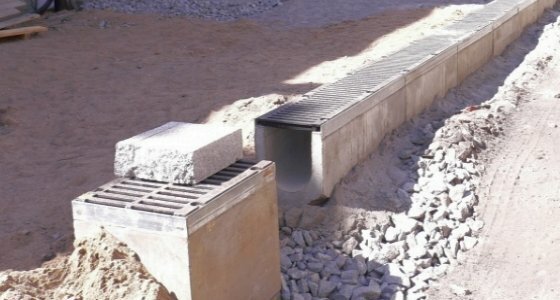
During installation, it is important to ensure that the edges of all gutters are 3 mm below the level of the covering. A protective grill is installed on top of them, which is fixed with bolts / clamps included in the kit
The connection of the linear drainage system to the general sewage system is carried out through sand traps. It is also important to provide for a point drainage device in places where water flows from the pipe.
As for the time of installation of the system, then specialists, if a small amount of work is expected, can cope even in one day.
Are you interested in the issue of arranging drainage in a private house? In this case, we recommend that you familiarize yourself with this article.
Drainage Regulatory Requirements
The arrangement of surface drainage of a modern city is regulated by a number of documents, starting with design, ending with requirements for the quality of materials and their technical characteristics.
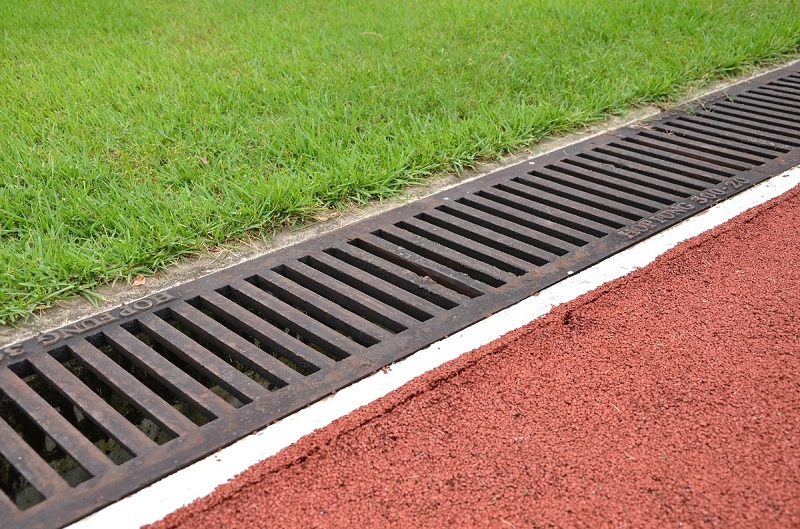
For example, sports complexes and sports grounds are in the sphere of influence of the Technical Committee of the International Association of Athletics Federation. Therefore, control over the device of drainage systems is carried out by this organization.
Next, let's look at the main ones:
- Arrangement of external sewerage networks - SNiPa 2.06.15-85.
- Design of systems for protection of territories from flooding and flooding - SP 104.13330.2016.
- General standards for the construction and improvement of urban areas Urban Development Code of the Russian Federation of December 29, 2004 N 190-FZ.
- General rules for the construction of buildings, structures and utilities - SNiP 12-01-2004.
- Drainage systems in road construction - STO 221 NOSTROY 2.25.103-2015.
- Installation of drainage networks in the construction of airfields - STO 221 NOSTROY 2.25.114-2015.
- And other regulations.
General requirements for materials for arranging drainage systems are set out in GOST 33068-2014 (EN 13252: 2005). Recommendations for the calculation of drainage systems in the construction of roads regulates ODM 218.2.055-2015. Specifications for storm water inlets are set out in GOST 3634-99.
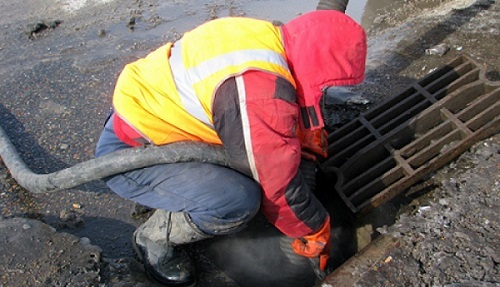
For the cleaning and cleaning of gutters, trays, pipes, drains and other engineering structures intended for the drainage of surface and ground water from the yards, the persons responsible for the cleaning of the respective territories
Conclusions and useful video on the topic
A guide for arranging a surface drainage system can be viewed in the following video:
A properly designed and installed drainage system will preserve the attractive appearance of landscaped areas of a modern city, garden plots and private households. It will also extend the service life of roads, bridges, building foundations and residential houses, reducing the hydraulic load on structures. But to create a drainage project, it is better to turn to specialists who will take into account the type of soil, climatic features and a number of other important points.
Do you have your own opinion on the advisability of a drainage system? Or would you like to supplement the above material with useful tips and facts? Write your comments, participate in discussions - the comment form is located a little below.


